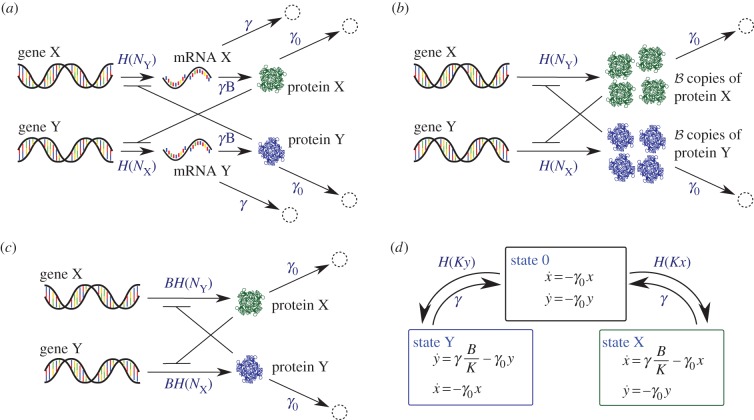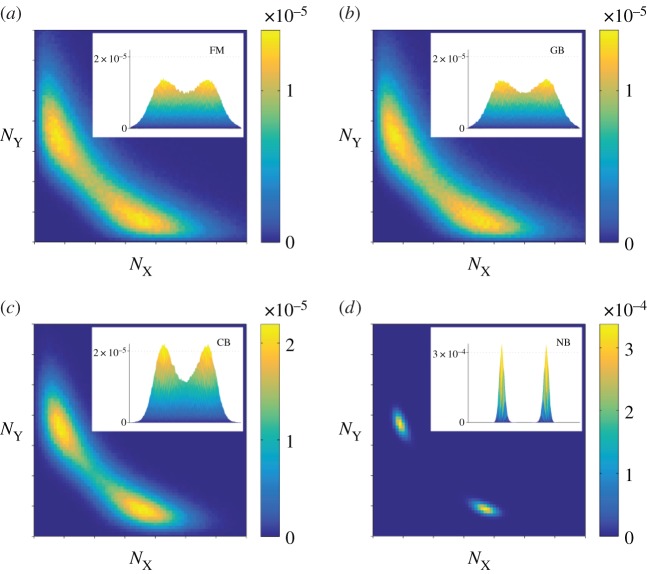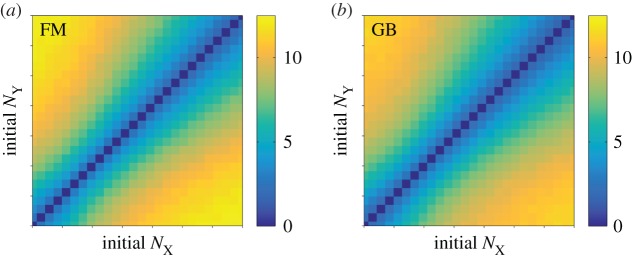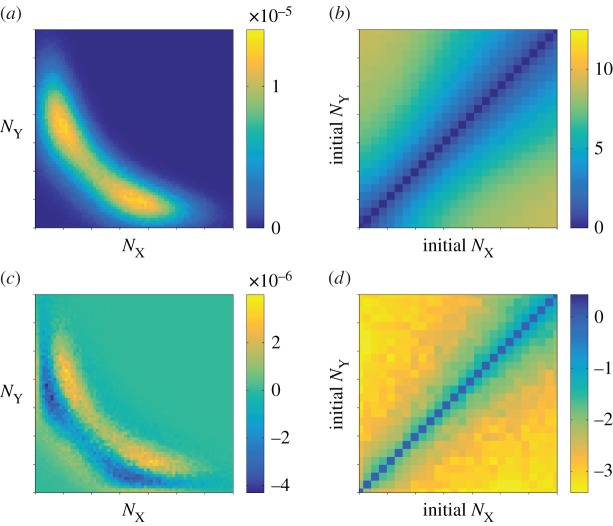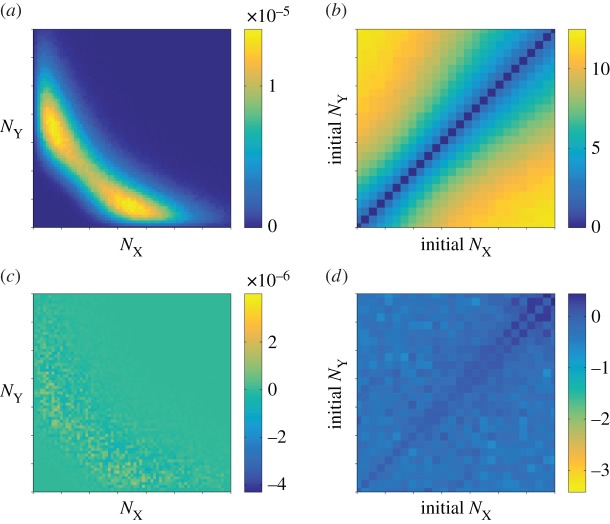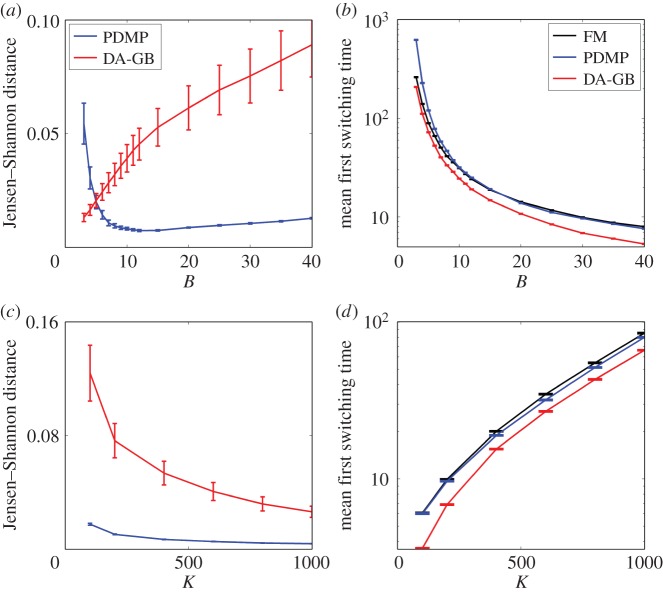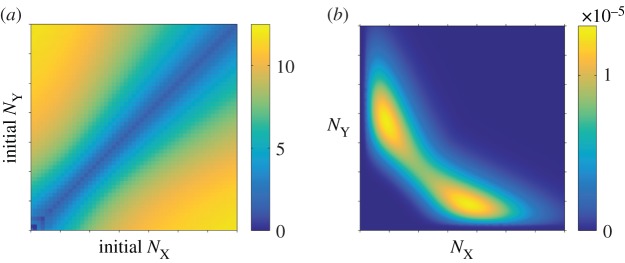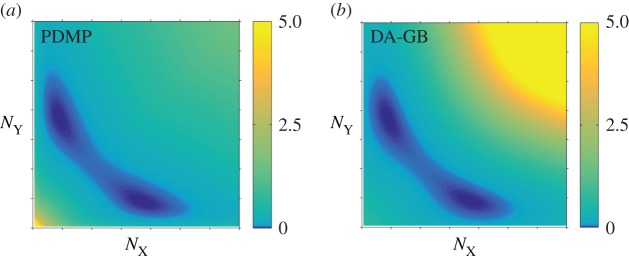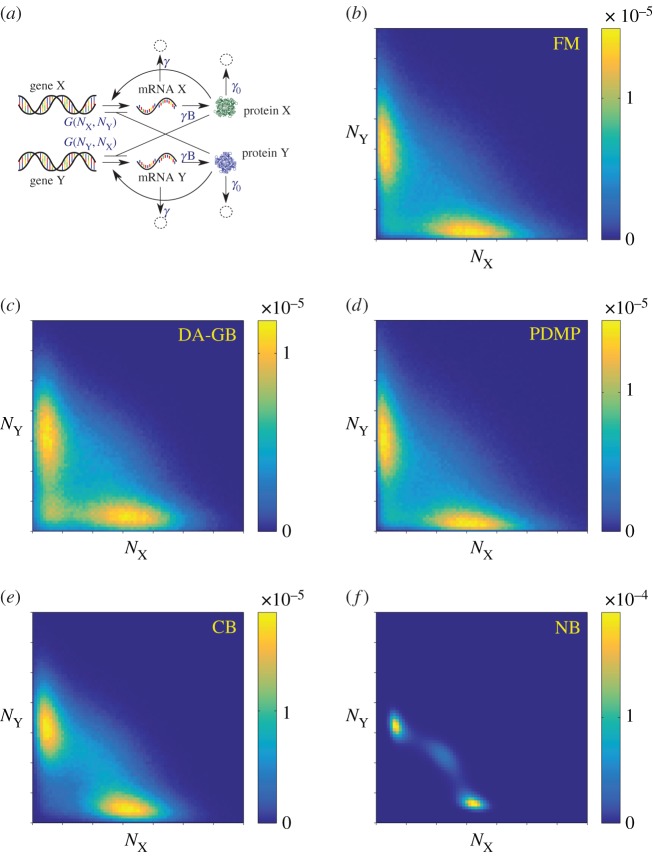Abstract
The dynamics of short-lived mRNA results in bursts of protein production in gene regulatory networks. We investigate the propagation of bursting noise between different levels of mathematical modelling and demonstrate that conventional approaches based on diffusion approximations can fail to capture bursting noise. An alternative coarse-grained model, the so-called piecewise deterministic Markov process (PDMP), is seen to outperform the diffusion approximation in biologically relevant parameter regimes. We provide a systematic embedding of the PDMP model into the landscape of existing approaches, and we present analytical methods to calculate its stationary distribution and switching frequencies.
Keywords: bursting noise, piecewise deterministic Markov process, stochastic processes, first passage times, weak noise limit, coarse-grained models
1. Introduction
Transcription and translation in the process of gene expression occur at the molecular level and in environments of relatively small copy numbers. The discreteness of the molecular dynamics and the inherent randomness with which reactions occur are known as ‘intrinsic noise’. It is now widely accepted that intrinsic noise plays an important role in gene regulatory networks [1–3]. It promotes epigenetic diversity and enhances the adaptability of a single phenotype in changing environments [4,5]. To investigate the effects of intrinsic noise, mathematical models at different levels have been constructed, ranging from microscopic models [3,6–10] describing the finer origins of intrinsic noise to mesoscopic models [11–15]. While the former capture the biological processes in more detail, the latter are computationally scalable and constructed to model more complex networks. These models all capture some signatures of intrinsic noise, but the detailed implementation of stochasticity varies from model to model. It is then important to consider how noise propagates between different levels of mathematical modelling. At present, coarse-grained models are often proposed ad hoc and not derived from the more detailed lower scale models. Is this always mathematically appropriate? What statistics of noise should modellers use at different levels of coarse graining? What are the consequences of the choice of noise statistics, and what are the pitfalls in deriving models on the meso-level from finer models on smaller scales? These are some of the questions we aim to address in this work.
The above difficulties in transitioning between different levels of modelling can nicely be illustrated in the context of biological switches. These are systems with different metastable states and the possibility to ‘switch’ between those states. Biological organisms with such behaviour include the Lac switch [6] in Escherichia coli and the Enterobacteria phage λ switch [7]. Computational and mathematical models of these range from very detailed descriptions [6,7] over individual-molecule approaches [8–10,16] to mesoscopic models [11,12,14,15].
The difficulties in connecting these different levels of modelling biological switches are amplified by the recent recognition that the mRNA populations are essential to describing the statistics of regulatory processes [16,17]. Biologically, mRNA molecules are a relatively short-lived source compared to the proteins into which they ultimately translate. Protein production from a given mRNA molecule proceeds while it exists, but ceases after the mRNA decays. This leads to a production of protein in bursts—that is, the production is active for a relatively short and random period of mRNA lifetime, and during that time a random number of proteins is generated. This phenomenon is termed translational bursting [1] and it can be observed in single-molecule experiments [18]. While some mesoscopic models account for such bursting [14,15], the theoretical investigation of these processes is often limited to their stationary distribution and frequently does not include dynamic features such as switching times.
The aim of our work is to investigate the effects of bursting noise in gene regulatory networks [9,10,11,13,16,19–21], and to construct connections between individual-based models and mesoscopic approaches. Specifically, we start from microscopic and individual-molecule-based models of a toggle switch and set out to construct coarse grained, mathematically tractable models without systematically biasing the outcomes.
2. Models of a toggle switch
2.1. Different scales of individual-based models
We compare four individual-based models and investigate the effect of bursting noise in a toggle switch network. The first model we consider describes both the mRNA and the protein population dynamics [16]. Figure 1a illustrates the Markovian model of the regulatory network. Genes X and Y are transcribed into mRNA X and mRNA Y, respectively, which in turn are translated to produce proteins X and Y. The transcription of each of the two genes is suppressed by proteins of the respective other type via a Hill function [2,3]  where N stands for the number of suppressing proteins. The model parameter K represents a typical population scale of the proteins, and the parameters r and r0 set the minimal (r0K) and maximal transcription rates (
where N stands for the number of suppressing proteins. The model parameter K represents a typical population scale of the proteins, and the parameters r and r0 set the minimal (r0K) and maximal transcription rates ( ). The parameter n > 0 is the so-called Hill coefficient which models the cooperative binding of the repressors [3]. More details of the reaction scheme can be found in the electronic supplementary material. Proteins of either type, and the mRNA molecules degrade with constant rates γ0 and γ, respectively. Biologically, mRNA molecules degrade much faster than the proteins do (
). The parameter n > 0 is the so-called Hill coefficient which models the cooperative binding of the repressors [3]. More details of the reaction scheme can be found in the electronic supplementary material. Proteins of either type, and the mRNA molecules degrade with constant rates γ0 and γ, respectively. Biologically, mRNA molecules degrade much faster than the proteins do ( ) [2,14,18]. The translation rate of the mRNA is parametrized by γB, where the parameter B is the relative frequency of protein production to mRNA degradation. In this parametrization, the number of proteins one single mRNA molecule produces during its lifetime is a geometrically distributed random variable with mean B (see the electronic supplementary material). Biologically, the parameter B varies depending on the type of product protein [22]. We assume
) [2,14,18]. The translation rate of the mRNA is parametrized by γB, where the parameter B is the relative frequency of protein production to mRNA degradation. In this parametrization, the number of proteins one single mRNA molecule produces during its lifetime is a geometrically distributed random variable with mean B (see the electronic supplementary material). Biologically, the parameter B varies depending on the type of product protein [22]. We assume  in this work [2,8] to investigate the effect of translational bursting. Together with the relatively short lifetime of mRNA molecules, this constitutes the origin of ‘translational bursting’ in the model [14,23]: a relatively large number of protein molecules is synthesized in a relatively short period of time.
in this work [2,8] to investigate the effect of translational bursting. Together with the relatively short lifetime of mRNA molecules, this constitutes the origin of ‘translational bursting’ in the model [14,23]: a relatively large number of protein molecules is synthesized in a relatively short period of time.
Figure 1.
Schematic diagrams illustrating the model dynamics. (a) Full model (FM) describing both the mRNA and the protein populations. (b) Protein-only model with geometrically distributed (GB) or constant (CB) bursts. The quantity  is a geometrically distributed random number with mean B in the GB model, and
is a geometrically distributed random number with mean B in the GB model, and  is a constant in the CB model. (c) Protein-only model without bursts (NB). (d) The piecewise deterministic Markov process (PDMP). (Online version in colour.)
is a constant in the CB model. (c) Protein-only model without bursts (NB). (d) The piecewise deterministic Markov process (PDMP). (Online version in colour.)
For simplicity, the process in figure 1a is assumed to be symmetric with respect to X and Y, but the analysis is easily generalized to asymmetric circuits. In table 1, we list a set of estimated values of the parameters for the model organism E. coli, along with relevant references. While the parameters of our model are expressed in time units of cell cycles, it is important to keep in mind that the model does not explicitly capture cell reproduction and cell division.
Table 1.
Parameter set.
| parameter | description | value | unit | references |
|---|---|---|---|---|
| B | average number of proteins each mRNA produces | 30 | molecule | [2] |
| γ | mRNA degradation rate | 30 | 1/(cell cycle) | [2] |
| γ0 | protein degradation rate | 1.0 | 1/(cell cycle) | [2,9,24] |
| r | maximum suppressed transcription rate | 6/100 | 1/(cell cycle) | [13,25]a |
| r0 | basal transcription rate | 1/150 | 1/(cell cycle) | [13,25]b |
| K | a typical population scale of the proteins | 200 | molecule | [13,25]c |
| n | Hill coefficient | 3.0 | dimensionless | [9,13,19,25] |
aIn [13], r = 1.8 and the time unit is defined as the inverse of the protein degradation rate. In the FM, we use this value, normalized by the mean burst size B = 39 molecules ( ).
).
bIn [13], r0 = 0.2. After normalizing with respect to the burst size 30, we obtain 1/150. In [25], r0 = 0.05r, which is of the same order as [13].
cIn [13], K is set to be 200 molecules. In [25], only the deterministic dynamics are provided and  To match the protein population scale ≈400 in [13,24], we impose rK = 400, resulting in a typical population scale of the proteins K ∼ 100 molecules, which is of the same order as that of Lu et al. [13].
To match the protein population scale ≈400 in [13,24], we impose rK = 400, resulting in a typical population scale of the proteins K ∼ 100 molecules, which is of the same order as that of Lu et al. [13].
In the context of this work, the model just described constitutes the most detailed model we will investigate and compare against. It serves as a starting point for the derivation of more coarse-grained models, and for these purposes we will refer to it as the ‘full model’ (FM) in the following. The FM is of course a simplified model itself, which does not describe the full complexity of the underlying biology. For example, it does not capture further genetic states accessed at a faster time scale, or dimerization processes which happen further downstream in the regulatory circuit [3,26]. We refer to it as the ‘FM’ solely to indicate that it is the most detailed model within the remit of this work.
The FM describes both the mRNA and the protein populations, hence it constitutes a relatively high-dimensional system which complicates the mathematical analysis. Notably, the only role of mRNA in the FM is to generate proteins, and so mRNA can be left out, so long as the correct statistics of protein production is retained. The timescale separation between the mRNA and protein lifetimes leads to the following reduced model describing only the protein dynamics. In the limit of infinitely fast mRNA degradation ( ), proteins are generated instantaneously in bursts of geometrically distributed sizes with a mean B, and in between bursting events protein populations decay with rate γ0. We will refer to the reduced model as the GB model (geometrically distributed bursts) (figure 1b; [17,22]). In the GB model, the transcription rates are regulated via the Hill function exactly as before in the FM.
), proteins are generated instantaneously in bursts of geometrically distributed sizes with a mean B, and in between bursting events protein populations decay with rate γ0. We will refer to the reduced model as the GB model (geometrically distributed bursts) (figure 1b; [17,22]). In the GB model, the transcription rates are regulated via the Hill function exactly as before in the FM.
A further reduction of the GB model involves replacing the GB sizes by a constant size B. We will call this the CB model (constant bursts) [8]. While the reduction of the FM to the model with geometrically distributed bursts is well controlled and exact in the limit  the effects of introducing CB sizes are unclear at this stage and require a detailed analysis (see below).
the effects of introducing CB sizes are unclear at this stage and require a detailed analysis (see below).
An even more reduced model is a model with no bursts [8–10], we will refer to this as the NB model. The reaction scheme is illustrated in figure 1c. In this model, only one single protein is synthesized when a transcription event occurs. We assume a B-fold increased transcription rate so that the average number of proteins synthesized per unit time is consistent with the FM, GB and CB models.
2.2. Stationary distributions
Numerical simulations of each of the models are carried out using standard methods [27,28]. In the following, we present statistical properties of the models, leaving typical sample paths to the electronic supplementary material. Figure 2 displays the numerically computed stationary distributions for the FM, GB, CB and NB models. In this section, we discuss the outcomes of the different models qualitatively. A more quantitative comparison of the stationary distributions can be found in the electronic supplementary material.
Figure 2.
Stationary distribution of protein numbers, shown in the range  on a linear scale on both axes. (a) FM: full model describing the mRNA and protein populations; (b) GB: protein-only model with geometrically distributed bursts; (c) CB: protein-only model with constant bursts; and (d) NB: protein-only model without bursts. (Online version in colour.)
on a linear scale on both axes. (a) FM: full model describing the mRNA and protein populations; (b) GB: protein-only model with geometrically distributed bursts; (c) CB: protein-only model with constant bursts; and (d) NB: protein-only model without bursts. (Online version in colour.)
The data in the figure illustrate that the profiles of protein expressions in different model settings are quite distinct. This is due to the different representations of the underlying intrinsic noise. While the stationary distributions of the FM and the GB model are in good agreement with each other, substantial discrepancies from the FM are found in the CB and NB models. In the CB model, the stationary distribution of protein numbers is very localized compared with the FM and the GB model. In the NB model, the probability distribution is even more sharply concentrated. This is because the NB model misses out two pertinent sources of noise. Bursting production in the CB model amplifies the stochasticity of transcription events and leads to a broadening of the protein distribution. Adding randomly distributed burst sizes (GB model) introduces further stochasticity and diversifies protein numbers even further. Based on these results, we conclude that the bursting noise introduced by the mRNA populations significantly broadens the stationary distribution. In addition, the GB model approximates the FM model significantly better than the CB and NB models do. We can effectively discard the CB and NB models as faithful representations of the FM, and our subsequent discussion hence focuses mostly on the GB model.
2.3. Mean first switching time
The toggle switch has two dynamic attractors, one in which protein X is highly expressed and where protein Y has a low concentration, and the other with inverted roles by symmetry. Starting from one attractor, the switch can be driven to the other attractor by fluctuations. The timescale of such a transition quantifies the dynamical stability: the longer the timescale, the more stable the system is at the initial position. As we will study next, the way in which the bursting production of protein is implemented significantly affects the timescale of these switching processes.
Starting from initial condition  and
and 
 we define the first switching time as the time it takes for a sample path to reach the symmetric boundary
we define the first switching time as the time it takes for a sample path to reach the symmetric boundary  Mathematically, the first switching time is a random variable. The mean first switching time (MFST) is then the average value of the random first switching time. The MFST depends on the initial condition
Mathematically, the first switching time is a random variable. The mean first switching time (MFST) is then the average value of the random first switching time. The MFST depends on the initial condition 
Sweeping across the space of possible initial configuration, the MFST of the FM and of the GB model are measured in simulations and presented in figure 3. We show the MFST of the CB in the electronic supplementary material. As with the stationary distributions, the data in figure 3 indicate that the GB model approximates the switching times of the FM to a good accuracy. A more detailed quantitative comparison is again provided in the electronic supplementary material. We remark that the MFST of the CB model is almost twice as long as that of the GB and FM models, and the switching time in the NB model is longer than 1000 cell cycles (see the electronic supplementary material).
Figure 3.
MFST as a function of the initial protein numbers ( shown on a linear scale). (a) FM: full model; (b) GB model. (Online version in colour.)
shown on a linear scale). (a) FM: full model; (b) GB model. (Online version in colour.)
2.4. Diffusion approximation
The evolution of the protein population in the GB model is described by a master equation (see the electronic supplementary material). Solving master equations mathematically is however difficult and mostly limited to linear dynamics [22,29]. The only realistic way forward for a theoretical analysis is often the so-called diffusion approximation.
In the diffusion approximation, the discrete-molecule process is approximated by a Gaussian process for continuous concentrations—numbers of the different types of molecules normalized by a typical population scale. The Gaussian process satisfies a diffusion equation (the Fokker–Planck equation) [30,31]. Based on these methods, it is often possible to calculate or approximate the stationary behaviour and switching times of model gene networks. For existing studies in the context of toggle switches, see [11–13].
Deriving the diffusion approximation of the GB model requires modest modifications to the standard Kramers–Moyal expansion [30,31]. These modifications are necessary to account for the randomness induced by the GB size. Details of the derivation can be found in the electronic supplementary material, we here only report the final outcome. The expansion results in two coupled Itō stochastic differential equations for the concentrations  and
and  These are valid in the limit of large but finite populations [32] and they are of the form
These are valid in the limit of large but finite populations [32] and they are of the form
| 2.1a |
and
| 2.1b |
with drift v and diffusion D given by
| 2.2a |
and
| 2.2b |
The quantities  and
and  represent independent Wiener processes.
represent independent Wiener processes.
The diffusion approximation can only be expected to be accurate when molecule numbers are large so that the concentations xt and yt are effectively continuous. In principle, a similar analysis can also be applied to the master equations of the FM. In the FM, mRNA numbers are rather small though (typically less than 5, see the electronic supplementary material), so the Gaussian approximation does not capture the statistics of the intrinsic noise faithfully. Similarly, a further analysis of the CB and NB models can be carried out based on the diffusion approximation. Given that CB and NB models fail to reproduce the behaviour of the FM, these results are relegated to the electronic supplementary material.
Results from simulating the Gaussian process of equations (2.1a,b) are shown in figure 4. While the data for the stationary distribution (figure 4a) looks similar to that of the FM (figure 2a), notable discrepancies are manifest in the MFSTs (cf. figure 4b and figure 3a). In figure 4c,d, we show the differences between simulation outcomes of the FM and those of the diffusion approximation of the GB model. Although the GB model itself approximates the FM well (figures 2 and 3), we conclude that the diffusion approximation fails to capture the relevant model outcomes.
Figure 4.
Diffusion approximation of the protein-only model with geometrically distributed random bursts (GB). (a) Stationary distribution as a function of the protein numbers. (b) Mean first switching time (MFST) as a function of the initial protein numbers, in the unit of cell cycles. (c) Net deviation of the stationary distribution from the full model. (d) Net deviation of the MFST from the FM. All axes show the range  on linear scales. (Online version in colour.)
on linear scales. (Online version in colour.)
3. Construction of a new mesoscopic model
3.1. Piecewise deterministic Markov process
We have seen that the diffusion approximation of the GB model fails to reproduce the statistics of the FM. This underlines the need to construct coarse-grained models directly from the FM and without the intermediate step of a protein-only dynamics. We now proceed to introduce such a model. As before, we describe protein concentrations by continuous variables, x and y. The mRNA dynamics are captured by introducing three states: the 0-state describes phases in which no mRNA is present. In the X-state, there is one mRNA of type X and protein X is generated with rate γb. The quantity b = B/K is the mean burst size in the unit of protein concentration. No proteins of type Y are produced in the X-state. Similarly, in the Y-state, protein Y is generated with rate γb. Both types of protein are subject to natural degradation with rate γ0 in any of the three states.
This is described by the following deterministic differential equations:
| 3.1a |
| 3.1b |
| 3.1c |
The rates with which the system transits between the states are based on the dynamics of the FM:
 |
3.2 |
No transitions occur directly between the X- and Y-states. The kinetic scheme is illustrated in figure 1d.
The stochasticity and discreteness of the mRNA populations is reflected in the random transitioning between the 0-, X- and Y-states. Between these Markovian events, the protein concentrations evolve deterministically. We will refer to this model as the piecewise deterministic Markov process (PDMP).
Notably, at most one mRNA molecule of either type can be present in the PDMP at any time. Although the model can be generalized to allow more than one mRNA molecule, the analysis below shows that the lowest order approximation is sufficient to capture the relevant fluctuations of the mRNA dynamics.
3.2. Performance of mesoscopic models
As in the GB model, we work in the limit of infinitely fast-degrading mRNA ( ). Simulations of the PDMP model in this limit can be carried out using a minor modification of a previously proposed algorithm [15]. We measure the stationary distribution of the PDMP model and the MFSTs for different initial protein numbers. Results are shown in figure 5a,b, and we compare the outcome against that of the FM in figure 5c,d.
). Simulations of the PDMP model in this limit can be carried out using a minor modification of a previously proposed algorithm [15]. We measure the stationary distribution of the PDMP model and the MFSTs for different initial protein numbers. Results are shown in figure 5a,b, and we compare the outcome against that of the FM in figure 5c,d.
Figure 5.
PDMP approximation. (a) Stationary distribution. (b) MFST in the unit of cell cycles as a function of initial protein numbers. (c) Net deviation of the stationary distribution from the full model. (d) Net deviation of the MFST of the PDMP model from the FM. All axes are on linear scales and show the range  (Online version in colour.)
(Online version in colour.)
The simulation data indicate that the PDMP approximation outperforms the diffusion approximation of the GB model, and it provides a more faithful approximation to the FM. This is because the diffusion approximation introduces Gaussian noise. It retains some information about the variance of protein production and degradation, but it does not capture the geometrically distributed burst sizes in the GB model well enough. The PDMP approximation, on the other hand, models exponentially distributed bursts in protein concentration. The exponential distribution in the PDMP model is the analogue of the geometric distribution in the discrete-molecule GB model. While the PDMP model is an approximation as well, it retains the typical characteristics of the stationary distribution and switching times of the original model. At the same time, the PDMP model is suitable for further mathematical analysis (see below).
We now investigate the robustness of these findings. In figure 6, we vary two essential parameters, the mean burst size B and the population scale K, while keeping the other parameters fixed. We measure the Jensen–Shannon distance [33,34] between the resulting stationary distributions of the PDMP and that of the FM. Data are shown in figure 6a,c. We also compare the MFSTs starting from one of the stable modes (figure 6b,d). The figures also show results from the diffusion approximation of the GB model.
Figure 6.
Performance of the PDMP model and the diffusion approximation of the GB model (DA-GB). (a) Jensen–Shanon distance between the stationary distribution PDMP (and DA-GB) and the stationary distribution of the FM. (b) MFST for varying value of B at fixed K = 200. (c,d) Similar to (a,b) but now varying K at fixed B = 30. (Online version in colour.)
Results indicate that the PDMP model outperforms the diffusion approximation of the GB model for mean burst sizes of  We conclude that the bursting noise has to be considered in this biologically relevant regime [22]. The PDMP model incorporates only the bursting noise and neglects the demographic noise from random degradation of the proteins. The strength of this demographic noise is proportional to
We conclude that the bursting noise has to be considered in this biologically relevant regime [22]. The PDMP model incorporates only the bursting noise and neglects the demographic noise from random degradation of the proteins. The strength of this demographic noise is proportional to  The results in figure 6c,d indicate that the difference in describing intrinsic noise propagates to physical observables even when the noise is weak (K ≈ 1000 for fixed B = 30).
The results in figure 6c,d indicate that the difference in describing intrinsic noise propagates to physical observables even when the noise is weak (K ≈ 1000 for fixed B = 30).
4. Analytical investigations of the piecewise deterministic Markov process model
4.1. Forward equation
The simplicity of the PDMP approach allows us to proceed with a mathematical analysis. We here only outline the main steps, further details are reported in the electronic supplementary material. We denote the probability density that the system is in the 0-state and with protein densities x, y at time t by  Similarly, we write
Similarly, we write  and
and  when the system is in the X- or Y-states. The evolution of these distributions then follows the following forward equation
when the system is in the X- or Y-states. The evolution of these distributions then follows the following forward equation
 |
4.1 |
where  and
and  drive the deterministic flow and the random switching between states, respectively. These operators are of the form
drive the deterministic flow and the random switching between states, respectively. These operators are of the form
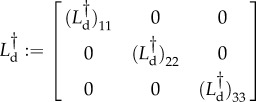 |
4.2a |
and
 |
4.2b |
with
| 4.3a |
| 4.3b |
| 4.3c |
The differential operators  and
and  act on all that follows to their right, including the probability densities
act on all that follows to their right, including the probability densities  and pY outside the matrix notation in equations (4.1) and (4.2).
and pY outside the matrix notation in equations (4.1) and (4.2).
The PDMP approximation applies in the limit  i.e. for fast return into the 0-state. The resident time in the X- and Y-states is exponentially distributed and scales as γ−1. It formally tends to zero as
i.e. for fast return into the 0-state. The resident time in the X- and Y-states is exponentially distributed and scales as γ−1. It formally tends to zero as  On the other hand, the translation rate γB tends to infinity in this limit. Combining the limiting behaviours of resident time and translation rate results in an exponentially distributed increment of protein concentration in each cycle of switching from the 0-state to the X- or Y-state, and then returning to the 0-state. As a consequence, the PDMP converges to previously proposed continuous-state bursting models [14,15,18] in the limit
On the other hand, the translation rate γB tends to infinity in this limit. Combining the limiting behaviours of resident time and translation rate results in an exponentially distributed increment of protein concentration in each cycle of switching from the 0-state to the X- or Y-state, and then returning to the 0-state. As a consequence, the PDMP converges to previously proposed continuous-state bursting models [14,15,18] in the limit  and
and  satisfies
satisfies
 |
4.4 |
as detailed in the electronic supplementary material.
4.2. Mean first switching time
One of the strengths of the PDMP formulation (equations (4.1) and (4.2)) is the relative ease with which MFSTs can be obtained. We first proceed by computing mean escape time from an arbitrary open domain Ω. The MFST can be calculated by setting  recognizing that the process can only exit this domain by crossing the boundary x = y.
recognizing that the process can only exit this domain by crossing the boundary x = y.
Suppose, the system is initially at  and in state
and in state  We write
We write  for the mean first time at which the process exits the domain Ω. The quantities Tz then satisfy the following backward equation [30,31]
for the mean first time at which the process exits the domain Ω. The quantities Tz then satisfy the following backward equation [30,31]
 |
4.5 |
where Ld and Ls are adjoint to the operators in equations (4.2). They are given by
 |
4.6a |
and
 |
4.6b |
with
| 4.7a |
| 4.7b |
| 4.7c |
The backward operator (4.6) can be derived either by one-step conditioning [30] or formally using Dynkin's formula [35]. In the infinitely fast-degrading mRNA limit ( ), and using appropriate boundary conditions (see the electronic supplementary material), we arrive at
), and using appropriate boundary conditions (see the electronic supplementary material), we arrive at
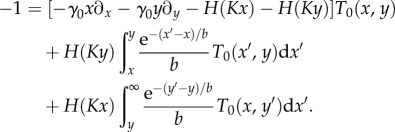 |
4.8 |
This is the adjoint equation [30] of the expression in equation (4.4) on the open domain Ω. Equation (4.8) is solved by a finite-difference method (see the electronic supplementary material), noting that it is self-consistent and no boundary condition needs to be specified. The solution is shown in figure 7 and reproduces the simulation outcome of the FM well.
Figure 7.
Theoretical prediction of the PDMP model. (a) Mean first passage time as a function of initial protein numbers, calculated from the backward equation 4.8). (b) Stationary distribution of protein numbers calculated from the WKB method. Axes of both panels show the range  on linear scales. (Online version in colour.)
on linear scales. (Online version in colour.)
We remark that equation (4.8) is only valid for the half-plane Ω. A detailed discussion can be found in the electronic supplementary material.
4.3. Stationary distribution in the weak-noise limit
The analytical calculation of the stationary distributions of the PDMP model can be pursued further using the so-called Wentzel–Kramers–Brillouin (WKB) method. This technique is based on the ansatz
 |
4.9 |
where  One proceeds by considering
One proceeds by considering  order-by-order in b. To leading order, we find the Hamilton–Jacobi equation
order-by-order in b. To leading order, we find the Hamilton–Jacobi equation
 |
4.10 |
where  This equation is then numerically solved using the algorithm of Heymann and Vanden–Eijnden [36]. Results are shown in figure 8. Even though this only provides a first-order approximation and despite the fact that we have used b = 0.15 (which is not very small), we obtain a reasonable agreement with the stationary distribution in figure 5a.
This equation is then numerically solved using the algorithm of Heymann and Vanden–Eijnden [36]. Results are shown in figure 8. Even though this only provides a first-order approximation and despite the fact that we have used b = 0.15 (which is not very small), we obtain a reasonable agreement with the stationary distribution in figure 5a.
Figure 8.
Quasi-potential S0 as function of the protein numbers  on a linear scale. (a) PDMP model. (b) Diffusion approximation of the GB model. (Online version in colour.)
on a linear scale. (a) PDMP model. (b) Diffusion approximation of the GB model. (Online version in colour.)
For completeness, we have also carried out a WKB analysis of the diffusion approximation of the GB, CB and NB models. These are presented in the electronic supplementary material.
The leading-order function S0(x, y) is the quasi-potential with respect to the stable fixed point, and it quantifies the rare-event statistics of the process in the weak-noise limit  [37,38]. Several studies have suggested that S0(x, y) is a suitable candidate for a ‘landscape’ of the non-equilibrium random processes in models of gene regulatory networks [9–11,16,17]. The Hamilton–Jacobi equation (4.10) contains cubic terms such as
[37,38]. Several studies have suggested that S0(x, y) is a suitable candidate for a ‘landscape’ of the non-equilibrium random processes in models of gene regulatory networks [9–11,16,17]. The Hamilton–Jacobi equation (4.10) contains cubic terms such as  while diffusion equations are quadratic in the derivatives of S0. This illustrates the fundamental difference between the statistics of intrinsic noise in the diffusion approximation and the bursting noise in the PDMP. Further more rigorous mathematical investigations into these differences would be very welcome in our view.
while diffusion equations are quadratic in the derivatives of S0. This illustrates the fundamental difference between the statistics of intrinsic noise in the diffusion approximation and the bursting noise in the PDMP. Further more rigorous mathematical investigations into these differences would be very welcome in our view.
We compare the functions S0 of the PDMP and the diffusion approximation of the GB model in figure 8. One observes a much ‘shallower’ quasi-potential in the PMDP model, especially at larger protein numbers ( ). This is due to the fat tails in the exponential bursting kernel of the PDMP model, which are not present in the diffusion approximation of the GB model. Such a fat-tail bursting kernel enhances the probability for the system to evolve to high protein concentrations. We identify this as the origin of the qualitatively distinct rare-event statistics in the two models.
). This is due to the fat tails in the exponential bursting kernel of the PDMP model, which are not present in the diffusion approximation of the GB model. Such a fat-tail bursting kernel enhances the probability for the system to evolve to high protein concentrations. We identify this as the origin of the qualitatively distinct rare-event statistics in the two models.
5. Bursting noise in a multi-switch network
Recently, multi-switch systems have gained interest [13,21,39]. A schematic diagram of the three-way switch network proposed by Lu et al. [13] is shown in figure 9a. It is obtained from the classical toggle switch network by including a self-enhancing autoregulation. Our computational and mathematical set-up requires only minor modifications to include generalization to this case. Specifically, we replace the earlier Hill functions by
| 5.1 |
with parameters [13] q0 = 4, r1 = −4/5, r2 = 7/3, n1 = 3, n2 = 1, K1 = 160 and K2 = 320. The rest of the parameters follow table 1. The negative value of r1 reflects the positive autoregulation. To evaluate the effects of bursting noise on this multi-switch model, we consider again the FM, the diffusion approximation of the GB model, as well as the CB and NB models of the extended network.
Figure 9.
(a) Schematic diagram illustrating the network of the three-way switch, remaining panels show stationary distribution of protein numbers in the range  on linear scale. (b) Full model; (c) diffusion approximation of the GB model; (d) PDMP approximation; (e) CB model; and (f) NB model. (Online version in colour.)
on linear scale. (b) Full model; (c) diffusion approximation of the GB model; (d) PDMP approximation; (e) CB model; and (f) NB model. (Online version in colour.)
Figure 9 displays the stationary distribution to illustrate the effects of the bursting noise in the multi-switch network. The model without bursts (NB, panel f) has a stationary distribution consisting of three modes, as reported earlier [13]. Inclusion of CB (panel e) diversifies the protein expression and reduces the stability of the mode located at  In the FM (panel b), there is no discernible concentration of probability in the symmetric mode, hence the three-way switching capability appears to be absent. We also note that the saddle of the distribution in the FM is located at a state with a much lower number of proteins compared with the NB and CB models. The most likely switching path [9] from one of the asymmetric modes to the other will differ significantly between the different variants of the model. The diffusion approximation of the GB model (panel (c)) does not capture the outcome of the FM either. Overall, these findings confirm again that the inclusion of bursting noise statistics has significant effects on the model outcome. Finally, we observe in figure 9d that the PDMP model approximates the FM of the three-way switch well. We conclude that randomly distributed burst sizes are again the predominant form of intrinsic noise in the multi-switch network.
In the FM (panel b), there is no discernible concentration of probability in the symmetric mode, hence the three-way switching capability appears to be absent. We also note that the saddle of the distribution in the FM is located at a state with a much lower number of proteins compared with the NB and CB models. The most likely switching path [9] from one of the asymmetric modes to the other will differ significantly between the different variants of the model. The diffusion approximation of the GB model (panel (c)) does not capture the outcome of the FM either. Overall, these findings confirm again that the inclusion of bursting noise statistics has significant effects on the model outcome. Finally, we observe in figure 9d that the PDMP model approximates the FM of the three-way switch well. We conclude that randomly distributed burst sizes are again the predominant form of intrinsic noise in the multi-switch network.
6. Discussion and conclusion
Explicitly including mRNA dynamics in gene regulatory models inevitably introduces more complexity. We have quantitatively studied the effects of bursting noise [1] in a biologically relevant regime of the model organism E. coli. To our knowledge, this is one of the first attempts to build a more rigorous connection between existing individual-based models [3,8–10] and coarse-grained models [11,12,14,15].
We have investigated two biologically motivated observables: the stationary distribution of the protein expression and the MFST of the biological switch. The stationary distribution serves as an approximation of the epigenetic distribution of a collection of a large number of similar cells. While the stationary distribution quantifies time-independent properties of the system at long times, the MFST is a measure of the timescale of spontaneous switching. It provides a quantitative characterization of the stability of the switch against intrinsic noise. We note that other quantities, not studied in this work, may be of biological interest as well, for example temporal correlations of fluctuations or indeed the nature of the path taken during switches between states. Our results indicate that the bursting statistics of transcription and translation are essential ingredients of models of gene regulation. Coarse-grained models need to account for bursting to retain correct statistics of noise-driven phenomena such as the switching between different dynamic attractors.
The implications of our observations are relevant to the abstract modelling of regulatory networks in different ways. We are now in a better position to address our opening question and to say how noise propagates between different levels of modelling. Perhaps more importantly, our study may ultimately help to decide what level of modelling is most appropriate to study gene regulatory circuits computationally. The answer will of course depend on the precise nature of the question that is asked. We have examined different levels of coarse graining, and we have identified the steps in these reduction procedures at which significant alternations to different model outcomes are introduced.
Systematically choosing a suitable level of coarse graining also facilitates the mathematical analysis of regulatory networks. The high dimensionality of full regulatory networks effectively makes them intractable. Model reduction is needed to make progress, and our analysis demonstrates that the PDMP formulation is a powerful way forward, and that it can be more suitable than the conventional diffusion approximation. The PDMP model explicitly retains the bursting noise originating from the mRNA dynamics. Even though it effectively disregards the demographic noise from random degradation of the proteins, it delivers accurate predictions for stationary distributions and switching times. We remark that for a lower dimensional system—an autoregulated network—the PDMP approximates the individual-based model as well to a good accuracy and we provide analysis separately [40].
As another strength, the PDMP formulation can be generalized relatively easily to accommodate more complex reactions. For example, in the Enterobacteria phage λ switch, it is not the monomer of the synthesized proteins which acts as the repressor to regulate transcription, but instead their dimer. Modelling these processes requires the inclusion of dimerization further downstream after transcription and translation [7,10,26]. Preliminary results not shown here reveal that the PDMP approximates such dynamics well. In addition, the formulation can be generalized to model the switching between genetic states [26,41].
The fact that the PDMP is successful in approximating the FM opens a relatively new type of modelling paradigm. We acknowledge that we are not the first to propose this type of model [41–46]. Our contribution consists of a first analytical treatment of PDMP models in the shot-noise limit  to investigate the bursting nature due to the presence of short-lived mRNA molecules in prokaryotic cells. This is in contrast to the previously cited references which focus on eukaryotic cells. We have also provided a more systematic embedding of PDMP into a wider landscape of modelling approaches.
to investigate the bursting nature due to the presence of short-lived mRNA molecules in prokaryotic cells. This is in contrast to the previously cited references which focus on eukaryotic cells. We have also provided a more systematic embedding of PDMP into a wider landscape of modelling approaches.
The bursting phenomenon is ubiquitous whenever there is a separation of timescales between the source and the product of a biological process. These are mRNA and protein in models of gene regulation, but we expect that these ideas can be applied to other biological problems with similar timescale separation.
Supplementary Material
Acknowledgement
We thank Peter Ashcroft, Luis Fernandez–Lafuerza, Louise Dyson, Eric Vanden–Eijnden, Oliver Jensen and Charlie Doering for fruitful discussions.
Authors' contributions
Y.T.L. conceived the study and carried out the analytical calculations and simulations. T.G. contributed to the research providing general direction. Both authors wrote the manuscript.
Competing interests
We declare we have no competing interests.
Funding
The authors acknowledge support from the Engineering and Physical Sciences Research Council EPSRC (UK) (grant no. EP/K037145/1).
References
- 1.Kaern M, Elston TC, Blake WJ, Collins JJ. 2005. Stochasticity in gene expression: from theories to phenotypes. Nat. Rev. Genet. 6, 451–464. ( 10.1038/nrg1615) [DOI] [PubMed] [Google Scholar]
- 2.Thattai M, van Oudenaarden A. 2001. Intrinsic noise in gene regulatory networks. Proc. Natl Acad. Sci. USA 98, 8614–8619. ( 10.1073/pnas.151588598) [DOI] [PMC free article] [PubMed] [Google Scholar]
- 3.Walczak AM, Mugler A, Wiggins CH. 2012. Analytic methods for modeling stochastic regulatory networks. Methods Mol. Biol. 880, 273–322. ( 10.1007/978-1-61779-833-7_13) [DOI] [PubMed] [Google Scholar]
- 4.Thattai M, van Oudenaarden A. 2004. Stochastic gene expression in fluctuating environments. Genetics 167, 523–530. ( 10.1534/genetics.167.1.523) [DOI] [PMC free article] [PubMed] [Google Scholar]
- 5.Acar M, Mettetal JT, van Oudenaarden A. 2008. Stochastic switching as a survival strategy in fluctuating environments. Nat. Genet. 40, 471–475. ( 10.1038/ng.110) [DOI] [PubMed] [Google Scholar]
- 6.Roberts E, Magis A, Ortiz JO, Baumeister W, Luthey-Schulten Z. 2011. Noise contributions in an inducible genetic switch: a whole-cell simulation study. PLoS Comput. Biol. 7, e1002010 ( 10.1371/journal.pcbi.1002010) [DOI] [PMC free article] [PubMed] [Google Scholar]
- 7.Arkin A, Ross J, McAdams HH. 1998. Stochastic kinetic analysis of developmental pathway bifurcation in phage λ-infected Escherichia coli cells. Genetics 149, 1633–1648. [DOI] [PMC free article] [PubMed] [Google Scholar]
- 8.Walczak AM, Sasai M, Wolynes PG. 2005. Self-consistent proteomic field theory of stochastic gene switches. Biophys. J. 88, 828–850. ( 10.1529/biophysj.104.050666) [DOI] [PMC free article] [PubMed] [Google Scholar]
- 9.Roma DM, O'Flanagan RA, Ruckenstein AE, Sengupta AM, Mukhopadhyay R. 2005. Optimal path to epigenetic switching. Phys. Rev. E 71, 011902 ( 10.1103/PhysRevE.71.011902) [DOI] [PubMed] [Google Scholar]
- 10.Warren PB, ten Wolde PR. 2005. Chemical models of genetic toggle switches. J. Phys. Chem. B 109, 6812–6823. ( 10.1021/jp045523y) [DOI] [PubMed] [Google Scholar]
- 11.Wang J, Zhang K, Xu L, Wang E. 2011. Quantifying the Waddington landscape and biological paths for development and differentiation. Proc. Natl Acad. Sci. USA 108, 8257–8262. ( 10.1073/pnas.1017017108) [DOI] [PMC free article] [PubMed] [Google Scholar]
- 12.Wang J, Xu L, Wang E, Huang S. 2010. The potential landscape of genetic circuits imposes the arrow of time in stem cell differentiation. Biophys. J. 99, 29–39. ( 10.1016/j.bpj.2010.03.058) [DOI] [PMC free article] [PubMed] [Google Scholar]
- 13.Lu M, Onuchic J, Ben-Jacob E. 2014. Construction of an effective landscape for multistate genetic switches. Phys. Rev. Lett. 113, 078102 ( 10.1103/PhysRevLett.113.078102) [DOI] [PubMed] [Google Scholar]
- 14.Friedman N, Cai L, Xie XS. 2006. Linking stochastic dynamics to population distribution: an analytical framework of gene expression. Phys. Rev. Lett. 97, 168302 ( 10.1103/PhysRevLett.97.168302) [DOI] [PubMed] [Google Scholar]
- 15.Bokes P, King JR, Wood ATA, Loose M. 2013. Transcriptional bursting diversifies the behaviour of a toggle switch: hybrid simulation of stochastic gene expression. Bull. Math. Biol. 75, 351–371. ( 10.1007/s11538-013-9811-z) [DOI] [PubMed] [Google Scholar]
- 16.Strasser M, Theis FJ, Marr C. 2012. Stability and multiattractor dynamics of a toggle switch based on a two-stage model of stochastic gene expression. Biophys. J. 102, 19–29. ( 10.1016/j.bpj.2011.11.4000) [DOI] [PMC free article] [PubMed] [Google Scholar]
- 17.Assaf M, Roberts E, Luthey-Schulten Z. 2011. Determining the stability of genetic switches: explicitly accounting for mRNA noise. Phys. Rev. Lett. 106, 248102 ( 10.1103/PhysRevLett.106.248102) [DOI] [PubMed] [Google Scholar]
- 18.Cai L, Friedman N, Xie XS. 2006. Stochastic protein expression in individual cells at the single molecule level. Nature 440, 358–362. ( 10.1038/nature04599) [DOI] [PubMed] [Google Scholar]
- 19.Gardner TS, Cantor CR, Collins JJ. 2000. Construction of a genetic toggle switch in Escherichia coli. Nature 403, 339–342. ( 10.1038/35002131) [DOI] [PubMed] [Google Scholar]
- 20.Wang J, Zhang J, Yuan Z, Zhou T. 2007. Noise-induced switches in network systems of the genetic toggle switch. BMC Syst. Biol. 1, 50 ( 10.1186/1752-0509-1-50) [DOI] [PMC free article] [PubMed] [Google Scholar]
- 21.Lu M, Jolly MK, Gomoto R, Huang B, Onuchic J, Ben-Jacob E. 2013. Tristability in cancer-associated microRNA-TF chimera toggle switch. J. Phys. Chem. B 117, 13164–13174. ( 10.1021/jp403156m) [DOI] [PubMed] [Google Scholar]
- 22.Shahrezaei V, Swain PS. 2008. Analytical distributions for stochastic gene expression. Proc. Natl Acad. Sci. USA 105, 17 256–17 261. ( 10.1073/pnas.0803850105) [DOI] [PMC free article] [PubMed] [Google Scholar]
- 23.Raj A, van Oudenaarden A. 2008. Nature, nurture, or chance: stochastic gene expression and its consequences. Cell 135, 216–226. ( 10.1016/j.cell.2008.09.050) [DOI] [PMC free article] [PubMed] [Google Scholar]
- 24.Taniguchi Y, Choi PJ, Li GW, Chen HY, Babu M, Hearn J, Emili A, Xie XS. 2010. Quantifying E. coli proteome and transcriptome with single-molecule sensitivity in single cells. Science 329, 533–538. ( 10.1126/science.1188308) [DOI] [PMC free article] [PubMed] [Google Scholar]
- 25.Kobayashi H, Kærn M, Araki M, Chung K, Gardner TS, Cantor CR, Collins JJ. 2004. Programmable cells: interfacing natural and engineered gene networks. Proc. Natl Acad. Sci. USA 101, 8414–8419. ( 10.1073/pnas.0402940101) [DOI] [PMC free article] [PubMed] [Google Scholar]
- 26.Jaruszewicz J, Lipniack T. 2013. Toggle switch: noise determines the winning gene. Phys. Biol. 10, 035007 ( 10.1088/1478-3975/10/3/035007) [DOI] [PMC free article] [PubMed] [Google Scholar]
- 27.Schwartz R. 2008. Biological modeling and simulation: a survey of practical models, algorithms, and numerical methods. Cambridge, UK: MIT Press. [Google Scholar]
- 28.Gillespie DT. 1977. Exact stochastic simulation of coupled chemical reactions. J. Phys. Chem. 81, 2340–2361. ( 10.1021/j100540a008) [DOI] [Google Scholar]
- 29.Kumar N, Platini T, Kulkarni RV. 2014. Exact distributions for stochastic gene expression models with bursting and feedback. Phys. Rev. Lett. 113, 268105 ( 10.1103/PhysRevLett.113.268105) [DOI] [PubMed] [Google Scholar]
- 30.van Kampen NG, VanKampen NG. 2007. Stochsatic processes in physics and chemistry. Amsterdam, The Netherlands: Elsevier Science B.V. [Google Scholar]
- 31.Gardiner CW. 2009. Handbook of stochastic methods. New York, NY: Springer. [Google Scholar]
- 32.Kurtz TG. 1971. Limit theorems for sequences of jump Markov processes approximating ordinary differential processes. J. Appl. Probab. 8, 344–356. ( 10.2307/3211904) [DOI] [Google Scholar]
- 33.Lin JH. 1991. Divergence measures based on the Shannon entropy. IEEE Trans. Inform. Theory 37, 145–151. ( 10.1109/18.61115) [DOI] [Google Scholar]
- 34.Endres DM, Schindelin JE. 2003. A new metric for probability distributions. IEEE Trans. Inform. Theory 49, 1858–1860. ( 10.1109/TIT.2003.813506) [DOI] [Google Scholar]
- 35.Klebaner FC. 2012. Introduction to stochastic calculus with applications. London, UK: Imperial College Press. [Google Scholar]
- 36.Heymann M, Vanden-Eijnden E. 2008. The geometric minimum action method: a least action principle on the space of curves. Comm Pure Appl. Math. 61, 1052–1117. ( 10.1002/cpa.20238) [DOI] [Google Scholar]
- 37.Freidlin MI, Wentzell AD. 2012. Random perturbations of dynamical systems. New York, NY: Springer. [Google Scholar]
- 38.Zhou JX, Aliyu MDS, Aurell E, Huang S. 2012. Quasi-potential landscape in complex multi-stable systems. J. R. Soc. Interface 9, 3539–3553. ( 10.1098/rsif.2012.0434) [DOI] [PMC free article] [PubMed] [Google Scholar]
- 39.Guantes R, Poyatos JF. 2008. Multistable decision switches for flexible control of epigenetic differentiation. PLoS Comput. Biol. 4, e1000235 ( 10.1371/journal.pcbi.1000235) [DOI] [PMC free article] [PubMed] [Google Scholar]
- 40.Lin YT, Doering CR. 2015. Gene expression dynamics with stochastic bursts: exact results for a coarse-grained model. (http://arxiv.org/abs/150802945) [DOI] [PubMed] [Google Scholar]
- 41.Jaruszewicz J, Zuk PJ, Lipniack T. 2013. Type of noises defines global attractors in bistable molecular regulatory systems. J. Theor. Biol. 317, 140–151. ( 10.1016/j.jtbi.2012.10.004) [DOI] [PMC free article] [PubMed] [Google Scholar]
- 42.Hasty J, Pradines J, Dolnik M, Collins JJ. 2000. Noise-based switches and amplifiers for gene expression. Proc. Natl Acad. Sci. USA 97, 2075–2080. ( 10.1073/pnas.040411297) [DOI] [PMC free article] [PubMed] [Google Scholar]
- 43.Zeiser S, Franz U, Wittich O, Liebscher V. 2008. Simulation of genetic networks modelled by piecewise deterministic Markov processes. IET Syst. Biol. 2, 113–135. ( 10.1049/iet-syb:20070045) [DOI] [PubMed] [Google Scholar]
- 44.Zeiser S, Franz U, Liebscher V. 2010. Autocatalytic genetic networks modeled by piecewise-deterministic Markov processes. J. Math. Biol. 60, 207–246. ( 10.1007/s00285-009-0264-9) [DOI] [PubMed] [Google Scholar]
- 45.Lipniacki T, Paszek P, Marciniak-Czochra A, Brasier AR, Kimmel M. 2006. Transcriptional stochasticity in gene expression. J. Theor. Biol. 238, 348–367. ( 10.1016/j.jtbi.2005.05.032) [DOI] [PubMed] [Google Scholar]
- 46.Bobrowski A, Lipniacki T, Pichór K, Rudnicki R. 2007. Asymptotic behavior of distributions of mRNA and protein levels in a model of stochastic gene expression. J. Math. Anal. Appl. 333, 753–769. ( 10.1016/j.jmaa.2006.11.043) [DOI] [Google Scholar]
Associated Data
This section collects any data citations, data availability statements, or supplementary materials included in this article.



